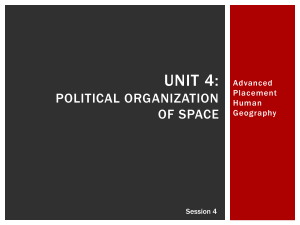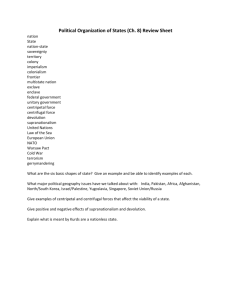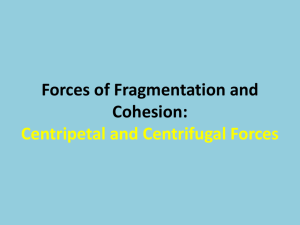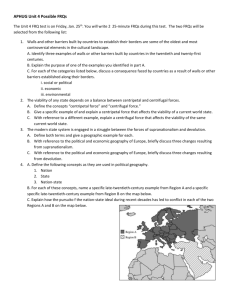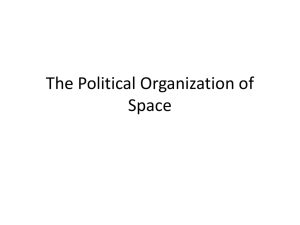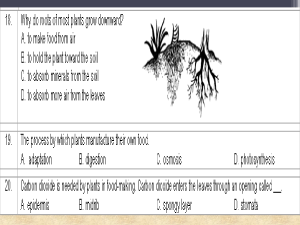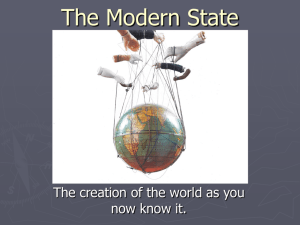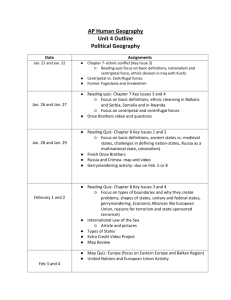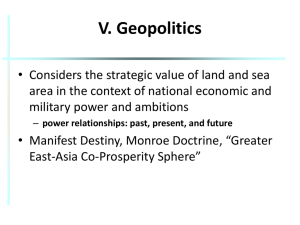Political #4
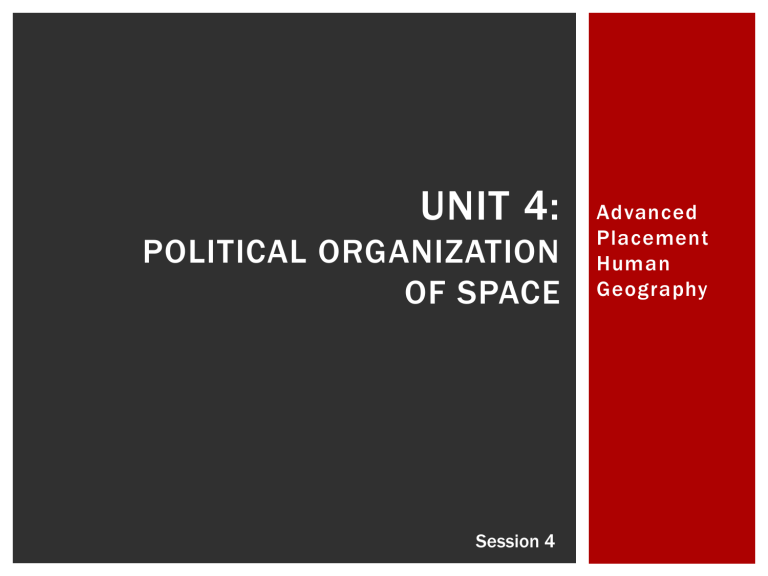
UNIT 4:
POLITICAL ORGANIZATION
OF SPACE
Advanced
Placement
Human
Geography
Session 4
MODERN CHALLENGES
TO THE
NATION-STATE CONFIGURATION
NATION-STATES ARE CHANGING
Nation-states have always had their challenges, both internal and external, but today new supranational forces are at work that have led some to believe that the nationstate political configuration itself may be changing.
SUPRANATIONAL ORGANIZATIONS
Supranational organizations are cooperating groups of nations that operate on either a regional or international level.
They establish rules that their members must follow.
Examples:
European Union (regional)
United Nations (international)
A recurring set of forces affects all nation-states: centripetal forces that unify them and centrifugal forces that tend to fragment them.
CENTRIPETAL FORCES
Centripetal forces bind together the people of a state, giving it strength.
One of the most powerful centripetal forces is nationalism , or identities based on nationhood.
CENTRIPETAL FORCES
How is nationalism promoted?
Use of symbols
Flags
Rituals
Holidays
Institutions
Schools
Armed forces
Religions
Transportation and communication systems
National broadcasting companies
CENTRIFUGAL FORCES
Centrifugal forces oppose centripetal forces.
They destabilize the government and encourage the country to fall apart.
Examples:
Governments are not well organized.
Weak institutions fail to provide support for the government.
CENTRIFUGAL FORCES
Strong institutions may also challenge the government for the loyalty of the people.
Example: Creation of the USSR in 1917
Leaders grounded the new country in the ideology of communism.
The state also forbid the practice of Russian
Orthodoxy, the traditional religion.
Church membership dropped, but the religious institution never disappeared.
When the USSR dissolved , the church reappeared and has since regained its strength.
CENTRIFUGAL FORCES
Nationalism can be a destabilizing force, especially if different ethnic groups within the country have more loyalty to their ethnicity than to the state or government.
These loyalties can lead to separatist movements.
CENTRIFUGAL FORCES
Separatist movements occur when nationalities within a country demand independence.
Example: Basques of northern
Spain
CENTRIFUGAL FORCES
What characteristics encourage separatist movements?
Peripheral location
Social inequality
Economic inequality
CENTRIFUGAL FORCES
One reaction states have had to centrifugal force is devolution, or the decentralization of decisionmaking to regional governments.
Example: Britain has devolved power to the Scottish and Welsh parliaments in an effort to keep peace with Scotland and Wales.
London still is the geographic center of decision-making for the country.
DEVOLUTION:
ETHNIC, ECONOMIC, AND
SPATIAL FORCES
TYPES OF DEVOLUTIONARY FORCES
Ethnic forces
Economic forces
Spatial forces
ETHNIC FORCES
If a state contains strong ethnic groups with identities that differ from those of the majority, it can threaten the territorial integrity of the state itself.
Ethnonationalism is the tendency for an ethnic group to see itself as a distinct nation with a right to autonomy or independence.
ETHNIC FORCES
Example of ethnic devolutionary forces: Quebec
Most French Canadians live in the province of Quebec.
This concentration has created a large base for an independence movement.
If ethnically French people were scattered throughout the country, their sense of identify would be diluted and the devolutionary force would be weaker.
ECONOMIC FORCES
Economic inequalities may destabilize a nation-state, particularly if the inequalities are regional.
Example: Italy
The “Ancona Line,” an invisible line extending from
Rome to the Adriatic coast at Ancona, separates the more prosperous north from the southern parts of
Italy.
Economic Devolutionary Forces in Italy and Spain
Geographically, southern Italy and most of Spain lie outside the
European core, creating economic devolutionary forces within the two nation-states.
SPATIAL FORCES
Spatially, devolutionary events most often occur on the margins of the state.
What promotes spatial devolution?
Distance
Remoteness
Peripheral location
This is especially true if the following separate the location from the center of power:
Mountains
Water
Desert
SPATIAL FORCES
Example: Puerto Rico
The U.S. claims Puerto Rico as a territory and has offered it recognition as a state.
Puerto Ricans have consistently voted against statehood.
Puerto Rico is an island in the Caribbean and it is spatially isolated from the rest of the U.S.
CHANGING GEOPOLITICAL
CONCERNS
WHAT IS GEOPOLITICS?
Geopolitics is the study of the spatial and territorial dimensions of power relationships within the global politicalterritorial order.
FRIEDRICH RATZEL
FriedrichRatzel was a geographer who theorized that a state compares to a biological organism with a life cycle from birth to death, with a predictable rise and fall of power.
This field became controversial after Hitler used this principle to justify the growth of the German state by attacking weaker states and aggressively
German nationalism.
promoting
British geographer Sir Halford
Mackinder concerned himself with power relationships surrounding
Britain’s global empire.
Naval power was responsible for
British power.
Mackinder believed, however, that land-based power would ultimately rule the world.
His theory stated that Eurasia was the
“pivot area.”
Eurasia
When the Soviet Union emerged as a super power after World War II, the heartland theory attracted a great deal of support.
• In 1944, Nicholas Spykman challenged the Heartland Theory in his book, The Geography of Peace.
• Spykman argued that the Eurasian rim , not its heart, held the key to global power.
• What is the rimland?
It is a large swath of land that encircles the heartland, roughly touching oceans and seas.
• The rimland includes:
• China
• Korea
• Japan
• Southeast Asia
• India
• Arabian Peninsula
• Europe
• This area is unlikely to fall under any one superpower’s control, an IMPORTANT key to keeping a global, geopolitical balance of power.
WHAT
DOES THE
RIMLAND
INCLUDE?
GEOPOLITICS
With increasing globalization , geopolitics has been reinvigorated.
The study of geopolitics was dominated by the
Cold War from 1945 to 1991.
GEOPOLITICS
The Cold War was the competition between two superpowers—the U.S. and Soviet Union—for control of land spaces all over the world.
With the fall of the Soviet Union in 1991, the U.S.
was left as the only superpower in a rapidly changing world that is being redefined.
EMERGING FORCES IN TODAY’S WORLD
Russia
China
Europe
KEY TERMS TO REVIEW
FROM THIS SESSION
Suprational organizations
Centripetal forces
Centrifugal forces
Separatist movements
Devolution
Ethnic forces
Ethnic groups
Ethnonationalism
Ethnic devolutionary forces
Spatial devolutionary forces
Geopolitics
Heartland Theory
Rimland Theory
Cold War
Superpower
